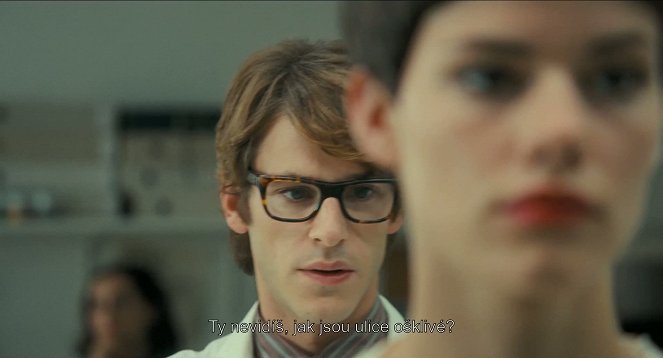Regie:
Bertrand BonelloKamera:
Josée DeshaiesBesetzung:
Gaspard Ulliel, Jérémie Renier, Louis Garrel, Léa Seydoux, Amira Casar, Aymeline Valade, Helmut Berger, Micha Lescot, Valeria Bruni Tedeschi (mehr)Streaming (2)
Inhalte(1)
Frankreich in den späten 60er und frühen 70er Jahren. Ein junger Mann namens Yves Saint Laurent entwickelt an der Seite des Modeschöpfers Christian Dior seine große Liebe zur Mode. Als Dior unerwartet stribt, wird Yves künstlerischer Leiter der renommiertesten Modemarke der Welt. Mit seinem Talent zur Mode verzaubert und inspiriert er die Menschen auf der ganzen Welt. Doch sein erfolgreiches Leben nimmt eine Wende, als er mit schlechter Kritik abgestraft wird. Daraufhin nimmt sein Leben selbstzerstörerische Züge an. Mehr und mehr taucht er in die Welt von Alkohol, Drogen und Sex ab und das große Modelabel droht in den Abgrund zu stürzen. Sein Manager und Lebenspartner Pierre Berge versucht das Unternehmen mit all seiner Kraft zusammenzuhalten. Der Film erzählt die Geschichte eines einzigartigen und außergewöhnlichen Designers. (Universum Film)
(mehr)Kritiken (2)
It’s been a long time since I was so happy for a film to end at the cinema. However, I have to admit that perhaps the filmmaker’s concept went over my head, since I didn’t manage to figure out what that concept might have been. When, with no apparent motivation, you start skipping around in time after a hundred minutes of episodes presented in chronological order, it actually comes across as a pseudo-sophisticated compositional device used out of spite. If the motivation was supposed to be Laurent’s drug-impaired ability to perceive reality in a non-fragmented way, the film doesn’t make that clear. The combination of an objective observational distance, when we watch Laurent watching someone else (a significant part of the film), with the audio-visual conveyance of his subjective states of perception (the somewhat tacky symbolism of a snake) similarly seems to lack any sort of conceptualisation. This is connected with the varying degree of distance that the narrative maintains from the main character and his lifestyle. The split-screen montage of tumultuous historical events on one side and Laurent’s fashion collections on the other comes across as caustic derision of the protagonist’s snobbish indifference to the socio-political context of the time. In comparison to that, the leitmotif of Laurent’s fruitless search for “Mondrian” perfection in both his life and his work is framed with all melodramatic seriousness. Bonello sympathises with the lonely fashion genius, gives no indication of ironic distance and ends the main narrative (before the epilogue) with Laurent’s triumphant return to his place in the sun, which for sufficient illustrative value is like a Mondrian painting. The distance from the character, which is also legitimised by the camera’s extraordinary interest in human body language, and the games played with chronology are only some of the techniques that the director uses to show that he didn’t want to make a conventional biopic, but was rather more interested in considering the meaning of films that try to cram a complex personality into a clearly comprehensible drama with a standard plot-development arc and many simplifying characteristics (Citizen Kane’s labyrinthine structure was similarly thematised). Some of the definitional shortcuts are heard in the film’s epilogue set in the Libération editorial office, while others were seen in the recent Yves Saint Laurent (2014). Whereas Lespert’s film characterised the eccentric fashion designer by means of a set of distinctive roles, Bonello rejects pigeonholing and shows Laurent as a unique being without a fixed essence who is reborn with each new collection (at least that’s how I understood the prominent shots of the Buddha statue). As in Sorrentino’s Il Divo, we can guess from the last shot what the protagonist’s provocative smile is expressing, who it is really intended for and what is hidden behind it (the shot also brings to mind the smile of another young man with a strong fixation on his mother, namely Norman Bates). Perhaps he is smiling at the futility of our attempt to understand him, to penetrate beneath the magnificent, always elegantly lighted surface. But Bonello couldn’t convince me that this impenetrability of the perfectly designed world of hidden emotions deserves a 150-minute, ostentatiously static and tediously monotonous film. 50%
()
(weniger)
(mehr)
I personally thought that this was a brutal suffering. 150 minutes of torture with no end. Also, the French filmmakers probably forgot to tell each other and ended up filming two very similar movies in a single year. And I can honestly say that this one is crazier, longer, more annoying and perhaps even creepier. There’s an effort, but I’m so not the target audience. If it weren’t for a challenge, I wouldn’t have even watched this.
()

